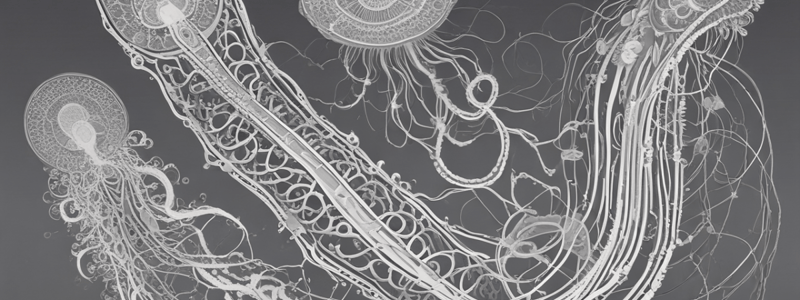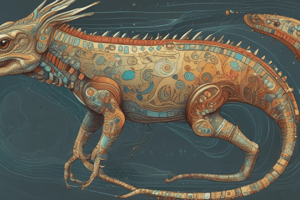Podcast
Questions and Answers
What is a characteristic of vertebrate embryos that is not found in invertebrate chordates?
What is a characteristic of vertebrate embryos that is not found in invertebrate chordates?
- Absence of Hox genes
- Presence of a four-chambered heart
- Possession of a one-chambered heart
- Development of neural crest cells along the neural tube edge (correct)
What is the primary function of the fin rays in vertebrates?
What is the primary function of the fin rays in vertebrates?
- Regulation of embryonic body plan along the head-tail axis
- Supporting the development of neural crest cells
- Determining segment structures in the vertebrate body
- Providing balance and propulsion during swimming (correct)
How do vertebrates differ from invertebrate chordates in terms of their Hox genes?
How do vertebrates differ from invertebrate chordates in terms of their Hox genes?
- Vertebrates lack Hox genes, while invertebrate chordates have one or more sets
- Vertebrates have one set of Hox genes, while invertebrate chordates have two or more sets
- Vertebrates have a unique set of Hox genes not found in invertebrate chordates
- Vertebrates have two or more sets of Hox genes, while invertebrate chordates have only one set (correct)
What is a characteristic of the circulatory system of vertebrates that is not found in invertebrate chordates?
What is a characteristic of the circulatory system of vertebrates that is not found in invertebrate chordates?
What is the embryonic source of many unique vertebrate traits?
What is the embryonic source of many unique vertebrate traits?
What is a characteristic of the body plan of vertebrates?
What is a characteristic of the body plan of vertebrates?
What is the characteristic that distinguishes vertebrates from invertebrate chordates?
What is the characteristic that distinguishes vertebrates from invertebrate chordates?
What is the significance of whole-genome duplication in chordate evolution?
What is the significance of whole-genome duplication in chordate evolution?
What is the morphological feature that is shared between lancelets and vertebrates?
What is the morphological feature that is shared between lancelets and vertebrates?
What is the relationship between Urochordata and vertebrates?
What is the relationship between Urochordata and vertebrates?
What is the significance of Hox genes in chordate development?
What is the significance of Hox genes in chordate development?
What is the characteristic of the ancestral chordates?
What is the characteristic of the ancestral chordates?
What is a shared, derived trait of Clade Vertebrata?
What is a shared, derived trait of Clade Vertebrata?
Which feature describes the body plan of basal vertebrates in clade Cyclostomes?
Which feature describes the body plan of basal vertebrates in clade Cyclostomes?
What is a notable feature of the body plan of conodonts, one of the earliest vertebrates?
What is a notable feature of the body plan of conodonts, one of the earliest vertebrates?
Which group of vertebrates went extinct by the end of the Devonian period?
Which group of vertebrates went extinct by the end of the Devonian period?
Which clade of vertebrates is characterized by the presence of jaws?
Which clade of vertebrates is characterized by the presence of jaws?
What type of vertebrates make up around 99% of all living vertebrates?
What type of vertebrates make up around 99% of all living vertebrates?
What is the primary structural protein found in the extracellular matrix of animals?
What is the primary structural protein found in the extracellular matrix of animals?
What is a shared, derived trait of Clade Gnathostomes that allows them to capture and process diverse foods?
What is a shared, derived trait of Clade Gnathostomes that allows them to capture and process diverse foods?
Which type of ossification is responsible for the formation of dermal skeletal structures in vertebrates?
Which type of ossification is responsible for the formation of dermal skeletal structures in vertebrates?
What type of bones are present in the vertebral column of early vertebrates like conodonts?
What type of bones are present in the vertebral column of early vertebrates like conodonts?
What is the characteristic of the fossil record of early gnathostome vertebrates from the Silurian-Devonian periods?
What is the characteristic of the fossil record of early gnathostome vertebrates from the Silurian-Devonian periods?
What is the characteristic of extant Chondrichthyans that distinguishes them from other vertebrates?
What is the characteristic of extant Chondrichthyans that distinguishes them from other vertebrates?
What is the term used to describe the 'plate-skinned' extinct armoured vertebrate fish?
What is the term used to describe the 'plate-skinned' extinct armoured vertebrate fish?
What is the difference between endoskeletal and dermal bones in vertebrates?
What is the difference between endoskeletal and dermal bones in vertebrates?
What is the characteristic of the dermal skeletal structures in living vertebrates?
What is the characteristic of the dermal skeletal structures in living vertebrates?
What is the evolutionary significance of the development of jaws in vertebrates?
What is the evolutionary significance of the development of jaws in vertebrates?
What is the name of the extinct placoderm fish that was approximately 10 meters in length?
What is the name of the extinct placoderm fish that was approximately 10 meters in length?
What is the characteristic of Clade Gnathostomes that distinguishes them from other vertebrates?
What is the characteristic of Clade Gnathostomes that distinguishes them from other vertebrates?
What is a characteristic of the skeleton of gnathostomes?
What is a characteristic of the skeleton of gnathostomes?
What is the likely reason for the evolution of larger and wider mouths in early gnathostomes?
What is the likely reason for the evolution of larger and wider mouths in early gnathostomes?
What is the result of genome duplication in gnathostomes?
What is the result of genome duplication in gnathostomes?
What is the function of the lateral line system in aquatic gnathostomes?
What is the function of the lateral line system in aquatic gnathostomes?
Which of the following is a characteristic of the forebrain in gnathostomes?
Which of the following is a characteristic of the forebrain in gnathostomes?
Study Notes
Vertebrate Characteristics
- Vertebrates have two or more sets of Hox genes, likely originating from whole-genome duplication, whereas invertebrate chordates (lancelets and tunicates) have only one set of Hox genes.
- Hox genes regulate the embryonic body plan along the head-tail axis, determining segment structures.
- Neural crest cells develop along the neural tube edge in vertebrate embryos and migrate within the embryo, contributing to structures such as teeth, certain skull bones/cartilage, and diverse types of neurons (nerves).
- Dorsal, anal, and tail fins are stiffened by fin rays along the centerline in vertebrates.
- Vertebrates possess a modified, complex circulatory system with a heart having at least two chambers.
Early Vertebrate Evolution
- Conodonts were among the earliest vertebrates in the fossil record, dating from 200–500 million years ago.
- Conodonts had cartilaginous cranium and vertebral column, were jawless, but possessed mineralized skeletal elements in their mouth and pharynx.
- Other groups of jawless vertebrates were armoured with defensive plates made of dermal bone on their skin.
- All early vertebrate groups, including conodonts and armoured jawless vertebrates, went extinct by the end of the Devonian period, following the evolution of jawed fish.
Clade Gnathostomes
- Gnathostomes are a clade of vertebrates that have jaws, with ~99% of all living vertebrates being gnathostomes.
- Gnathostomes include sharks and their relatives, ray-finned fishes, lobefinned fishes, amphibians, reptiles (including birds), and mammals.
- Gnathostomes have opposing jaws that open/close the mouth forcefully to capture and process diverse foods.
- Gnathostomes exhibit a mineralized skeleton, including mineralized teeth.
- Gnathostomes have two pairs of lateral appendages, such as fins or legs.
- Gnathostomes have an enlarged forebrain, which is associated with enhanced smell and vision.
- Aquatic gnathostomes possess a lateral line system that detects vibrations in the water.
Origin of Jaws and Mineralization of the Skeleton
- The earliest vertebrates likely had cartilaginous skeletons.
- The dermal skeletal structures are derived from intramembranous ossification (not from preformed cartilage).
- Formed external armor in early armored fishes, and is retained in living vertebrates, such as bony fin rays in fish, facial and pectoral bones, and teeth.
Studying That Suits You
Use AI to generate personalized quizzes and flashcards to suit your learning preferences.
Related Documents
Description
Explore the shared, derived traits of vertebrates and the presence of multiple sets of Hox genes, likely from whole-genome duplication. Learn how Hox genes regulate the embryonic body plan and determine segment structures. Delve into neural crest cell development and more in this quiz.




